BLOG ARTICLE
Best Tips To Grow Your Podcasts Listeners (2025)
Last updated: 11/18/2025
Last updated: 11/18/2025
Podcasting isn't easy and promoting your podcast is even harder. But there you are - you might have just published your first episode or perhaps, there's a content calendar for your podcast content.
But the truth is, creating good content is only the half battle. Promoting your show and connecting with a larger audience is more frustrating. But you're in luck with our ebook "35 Actionable Ideas to Grow Your Podcast." tailored to support podcasters like you in your pursuit of success.
Here are ideas from the ebook on how to promote your show and drive listeners to your episodes.

Growing your podcast audience is the ultimate marketing strategy for your podcast. It affects every other area of your show and opens you up to endless possibilities that the podcast industry provides.
1. Launch your podcast on Product Hunt
What is Product Hunt
Product Hunt is one of the best platforms to share new products in tech with 100,000+ visitors. So if you run a podcast related to tech, productivity, or marketing, a product hunt launch is a must.
For example, here's Lenny Podcast launching on ProductHunt with a fair amount of support.
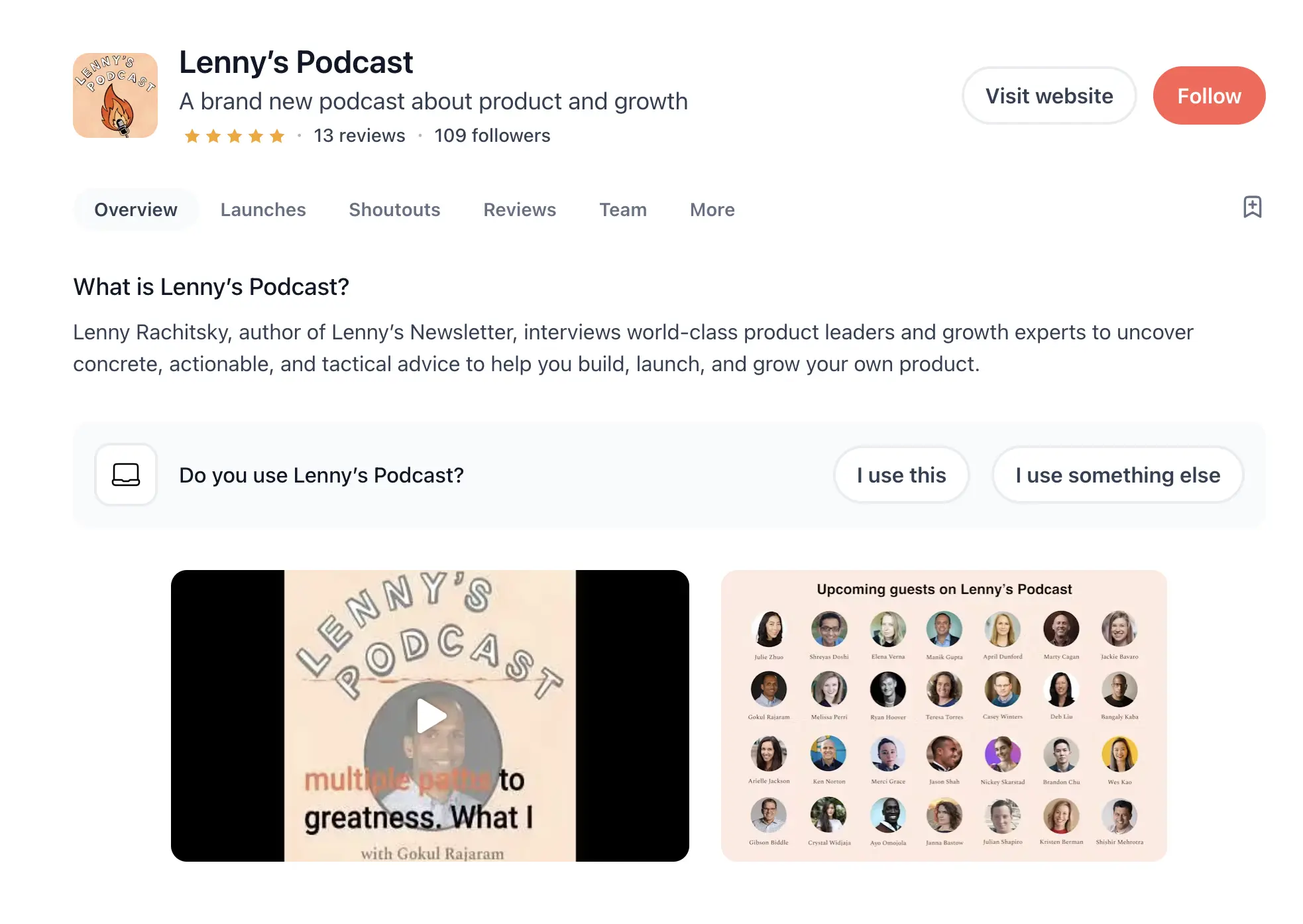
Or, how the Technically True podcast followed the same route to ProductHunt launch.
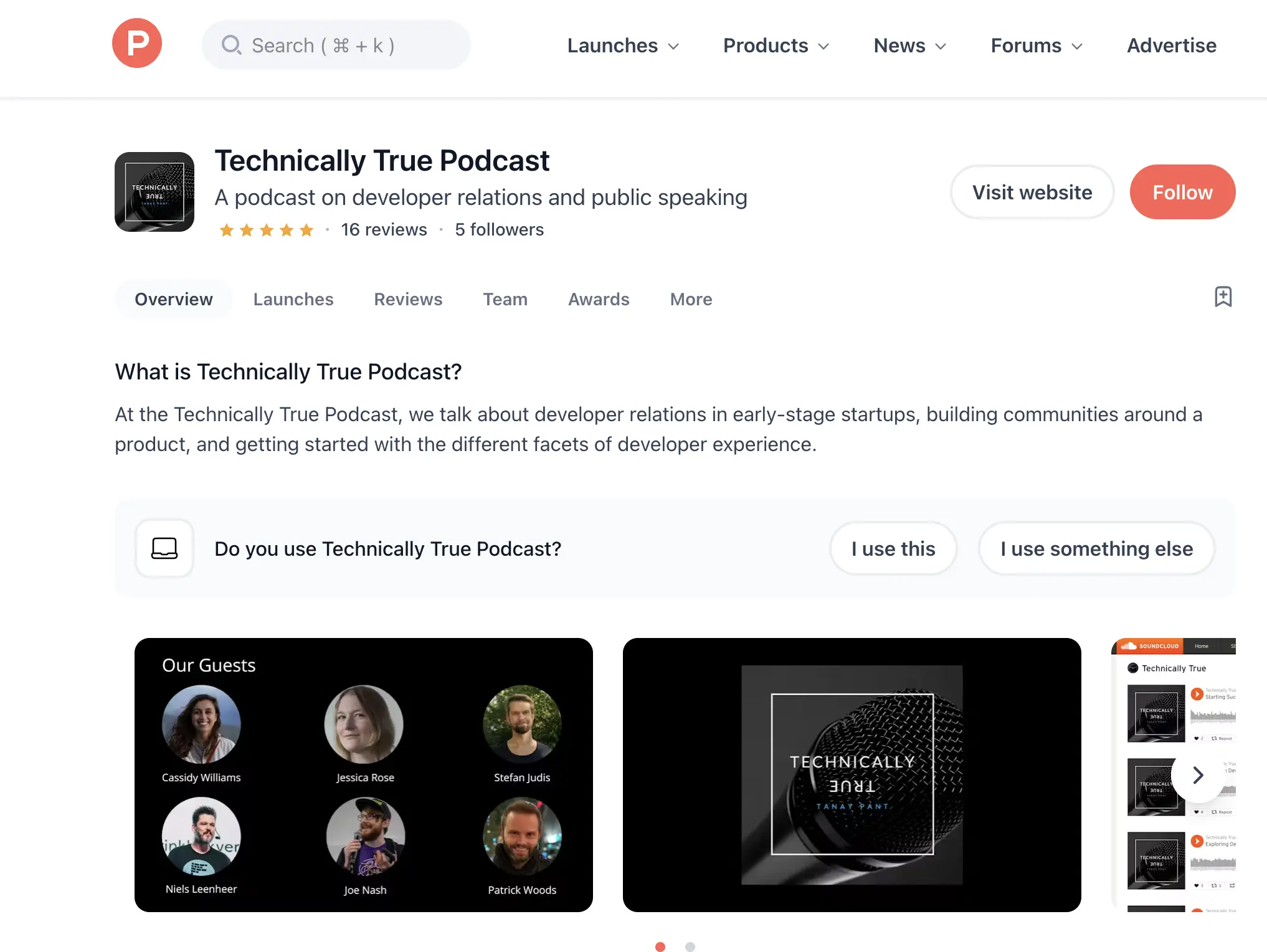
Benefits
1 - Put your podcast in front of thousands of tech enthusiasts
2 - Free Product Hunt coverage for your podcast
3 - Get valuable feedback for your podcast from the community
How to launch your podcast on Product Hunt
1 - Create an account on Product Hunt and schedule your launch
2 - Choose an ideal launch day (Sat/Sun are less competitive)
3 - Ask your listeners & followers to upvote you on launch day
2. Cross Promote with other niche podcast creators
Imagine collaborating with another podcaster who has audiences similar to your target listeners. Cross-promotion opens you up to an untapped listeners from other creators. All you need to do is collaborate on a topic on their show and also get them to come to yours (vice versa).
Benefits
- Open your podcast to an untapped audience of listeners
- Increase the brand awareness of your podcast
- Make relationships with other creators and grow together
How to cross-promote with other podcast creators
- Shoutout Swap: A shout-out swap is when you call out another podcast in exchange for that podcast creator doing the same for you. Typically they run for at least 30 seconds.
- Feed Drop: A feed drop is when you insert another creator’s audio into one of your episodes and vice versa. They can be part of an episode, an ending portion of an episode, or an entire episode by itself. If you decide to swap an entire episode, it’s best to set some context for your listeners at the start on why they should listen to it
- Co-hosting: Co-hosting is when you and another creator decide to collaborate on an episode or a series of episodes and publish it on both of your podcasts. This is a great way to exchange your audience with each other and also have fun while doing it.
How to find and approach podcast creators you can cross-promote with
- Search for podcasts that are related to your niche or that have a similar audience
- Drop them a DM on Twitter or an email proposing your idea.
- Finalize the cross-promotion and go live.
DM example
Hi. I run a podcast called “ _” on community building. And I would love to do a cross-promotion with your podcast, since we both share a common audience and have an opportunity to grow our following. What do you think?
Cost
Free if you both have an equal audience, but can be paid if you’re reaching out to a creator who has a bigger following than you
3. Grow your podcast on social media mentioning brands
What is it?
A growth hack to get more audience for your podcast is by mentioning brands/tools in your podcast that you use to get your work done or by mentioning people whom you get inspired.
Ex: I used Canva Pro to remove the background from my social media post images
Benefits
- Tag the big brands & influencers mentioned in your podcast on social media to get retweets and mentions for your posts.
- Introduce your podcast to 1000’s new audience.
- Opens up an opportunity to establish relationships with brands in your niche with whom you can collaborate or partner in the future.
How to find all the brands and products you’ve mentioned in your podcast
- Go to Podsqueeze and create an account
- Upload the audio file of your podcast or select the episode from your RSS feed
- Get the list of all the brands and tools that you’ve mentioned in your podcast
Example
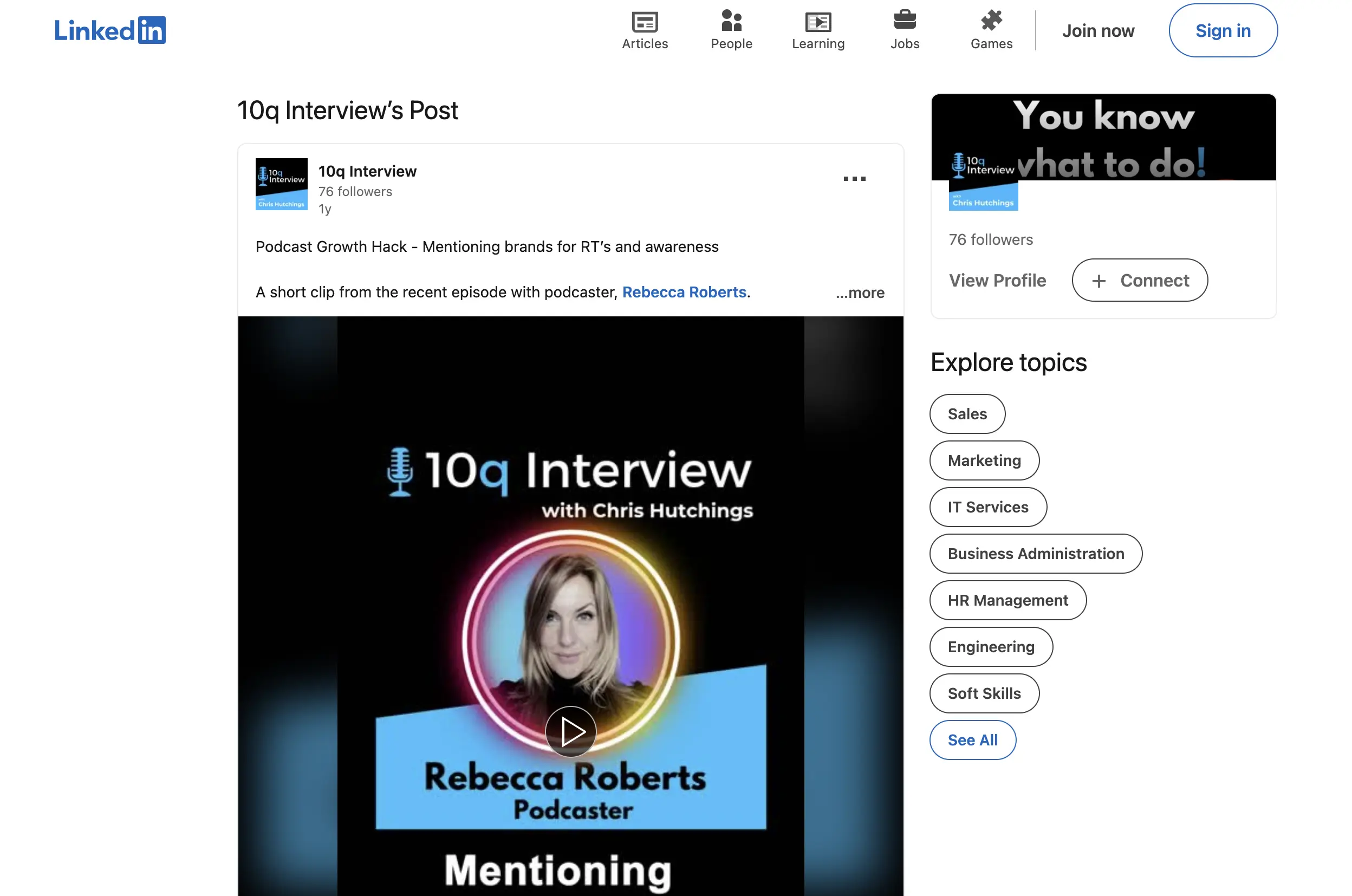
4. Pitch your podcast to the listicles
Listicles are a list of podcast recommendations that are shared on a website’s blog.
For example, here are podcast curated list that mentions good podcasts in a niche and audiences are more than willing to check them out.
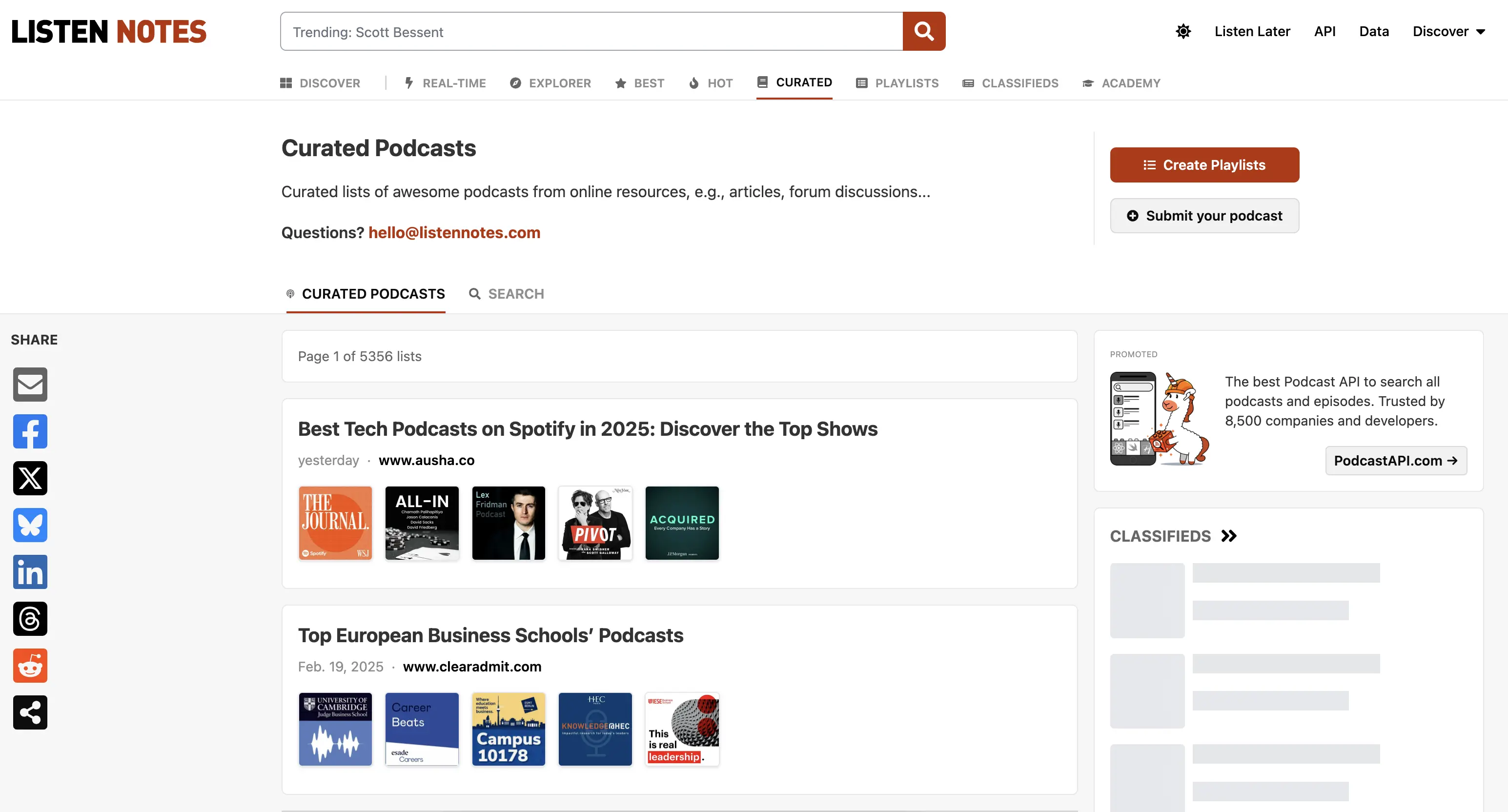
Other examples could be a list of "10 podcasts that every single mom should listen to" on Google and other search engines.
There are thousands of visits on these pages monthly and your goal should be to reach out to the manager of these pages and get a mention from to share from the pie of audiences that discover new podcasts through listicles.
Benefits
- If the list becomes popular, you will get hundreds of new downloads for your podcast
- Your podcast will reach a wide range of audience
- Will make your podcast a go-to podcast in your niche
How to pitch your podcast and get it added to listicles
- Search on Google for “best podcasts for ____ (your topic) Ex: Best podcast for self-improvement
- Make a list of websites that you want to reach out to
- Get their email address from the contacts page
- Email them requesting to add your podcast to their listicle, with a link to the podcast and why you feel it's a good fit for their listicle.
5. Join a Podcast Network
A podcast network is a group of podcasts that unite together by a similar theme, genre, partnership, or ownership. A podcast network provides a platform for podcasters to distribute their show, access production, network with other podcasters, and generate revenue from advertising and sponsorships.
How to find a podcast network
You need to find a podcast network that hosts shows that are similar to yours for the best results Here’s how you can find the podcast network that’s the best fit for you:
- Search on Google for “Podcast network + [your podcast topic/niche] Ex: Podcast network for marketing.
- Try asking on communities like r/podcasts for recommendations.
- Browse sites like Chartable.
Checklist to join a podcast network
- The number of followers for the network. The more it has, the better reach for you.
- Does the network have any creative restrictions on your content?
- How many other podcasters are part of the network & their credibility?
- The ad revenue & sponsorship share between you and the network.
- What is the support provided by the network? Do they offer promotional resources, access to sponsorships, and networking opportunities?
Top podcast networks
6. Ask guests to share your podcast with their audience
This might look like a simple tip but you'll be surprised how easily guests forget the podcasts they were on. It is your responsibility to leverage their influence and audiences by asking them to share the episode they were on and also send follow-ups, tag their social media profiles, or just send a complimentary email after they have been featured on your show.
Benefits
- Expand the listener circle for your podcast & get more downloads.
- Increase the social proof & authority of your podcast.
Ways you can ask guests to share your podcast
- Post a short video of your podcast on the guest’s social media (Linkedin, Instagram/ Twitter) with a podcast link.
- Request them to do an email blast with short notes of your podcast episode to their email newsletter subscribers.
- Convert your podcast into a post with Podsqueeze and publish the podcast on the guest website.
7. Share your advice and plug your podcast into communities
What is it?
Communities are a place where members post their problems and ask questions. You can reply to those questions and plug your podcast organically.
Benefits
As people are looking for a solution, they will listen to your podcast straightaway. Since they are your target audience, they will most likely subscribe to your podcast too.
How to find communities to plug
- Research communities that talk about your niche. For example: if your podcast is about marketing, search “marketing” on Reddit to find relevant subreddits & on Facebook to find relevant Facebook groups.
- You can use Hive Index to find communities faster.
- Read the rules for self-promotion in the communities.
- Answer people’s questions and plug your podcast if they allow self-promotion.
8. Write catchy titles for your podcast episode
Your title is the first thing an audience will notice when they see your episode. We can't overstate how important titles are to the success of your show.
Your titles should be appealing and relatable to the audiences to the point where they are intrigued to learn more and click. You can learn from top industry experts how they crafted their titles or let an AI tool like Podsqueeze craft the right catchy titles for your episodes.
Benefits
- A catchy title captures the attention of listeners and gets more clicks.
- Be easily searchable on podcast platforms.
How
- Go to the Podsqueeze website and upload your podcast’s audio file.
- Now, Podsqueeze will generate a list of catchy titles you can use for your episode.
- Pick the one that fits the best and add it to your episode.
5 Tips for having catchy titles for your podcast
- Ask questions in your titles. ex: What's the secret behind the success of the world's top podcasters?
- Add numbers in your title. ex: 5 steps to fix any problems at work
- Keep your titles between 80 to 95 characters for maximum engagement.
- Avoid spam words such as "trick", "secret","amazing", etc.
Learn More: How To Write Catchy Titles For Your Podcast
9. Create an alert for your podcast on Google alerts
Another creative idea to grow your podcast listeners is creating a Google alert for your podcast. By creating a Google alert for your podcast, you will be notified whenever someone mentions your podcast name on the internet.
Benefits
See the public reception of your podcast in real-time Reply and share the feedback about your podcast.
How to create a Google alert
- Go to Google Alerts.
- Enter your podcast name in the search box.
- Choose how often you want to be notified.
- Finally, click “Create alert”.
10. Post image quotes on social media
This is one of the most relatable growth strategies for podcasts. Oftentimes, you drop some quote-worthy speech in your episode. Such speeches could be made into quotes for sharing on social media and pulling audiences in.
If you know how to select the right quotes from your episode (which is often hard to do) or let AI do it for you, you will also be able to fill your podcast content calendar and up your podcast social media game because you'll always more quotable speech than you think.
Benefits
- Quotes get a good reach on social media. If your followers relate to the quote, they will share them in stories or retweet them. So your podcast will get more reach.
- Tagging a guest whose quote you posted, will give you a repost or retweet from the guest which will boost your podcast plays.
How to create an image quote
- Go to Podsqueeze and create an account.
- Upload the audio file of your podcast or select the episode from your RSS feed.
- Now Podsqueeze will generate an image quote for you, which you can edit according to your audience and post on social media.
Example
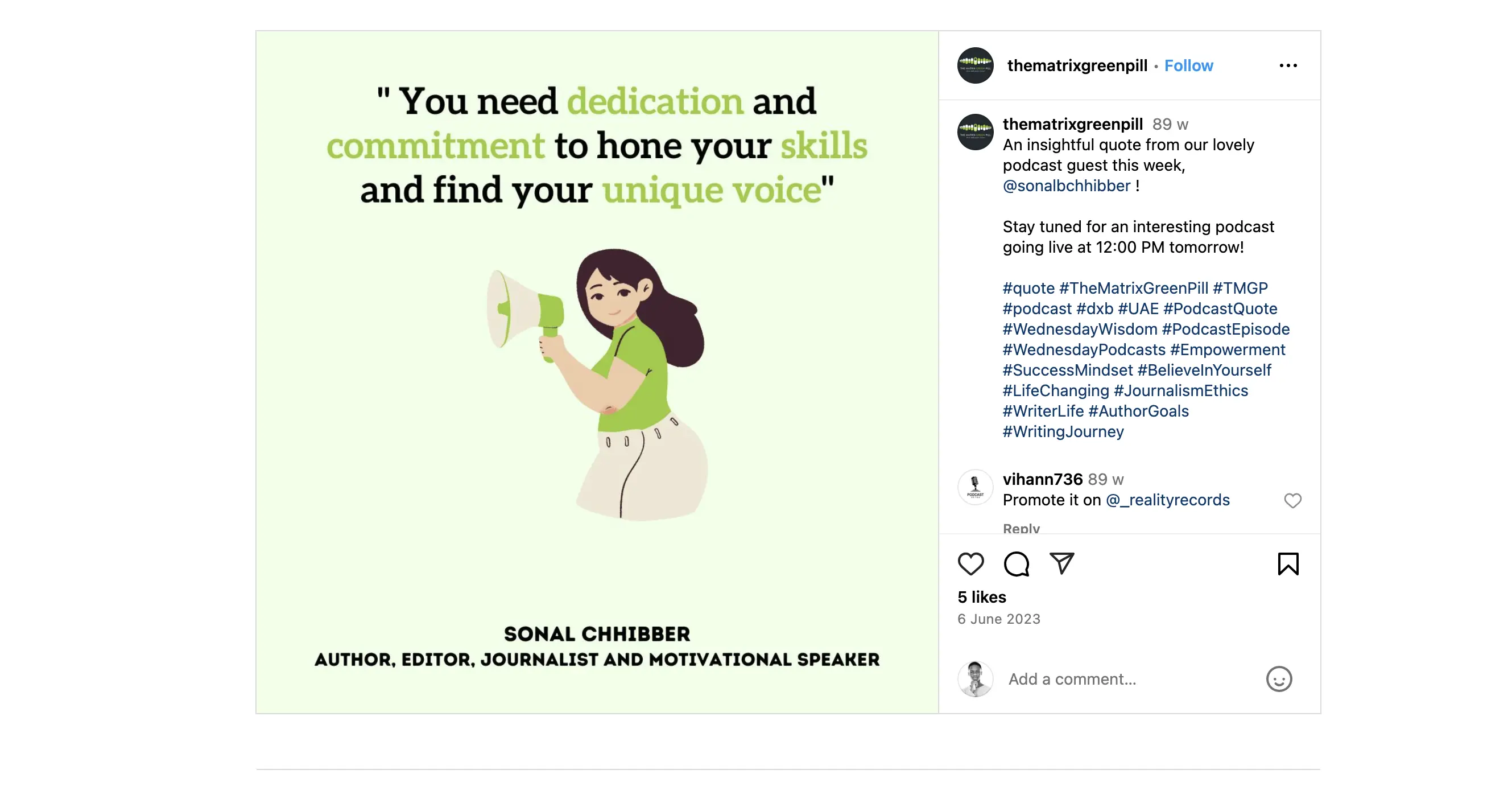
(Source)
Find more ideas to grow your podcast on our Free eBook
Repurpose your podcast content with AI
